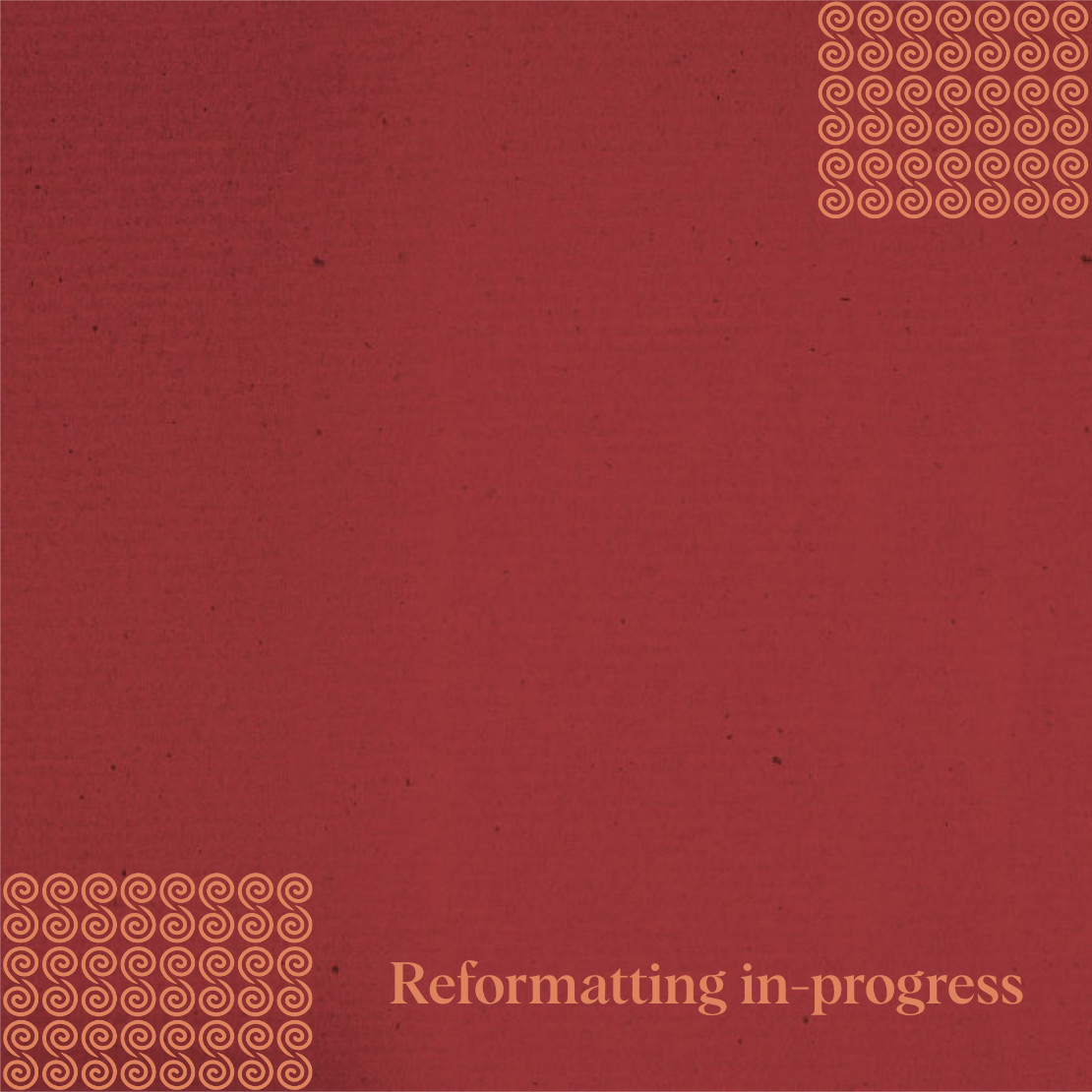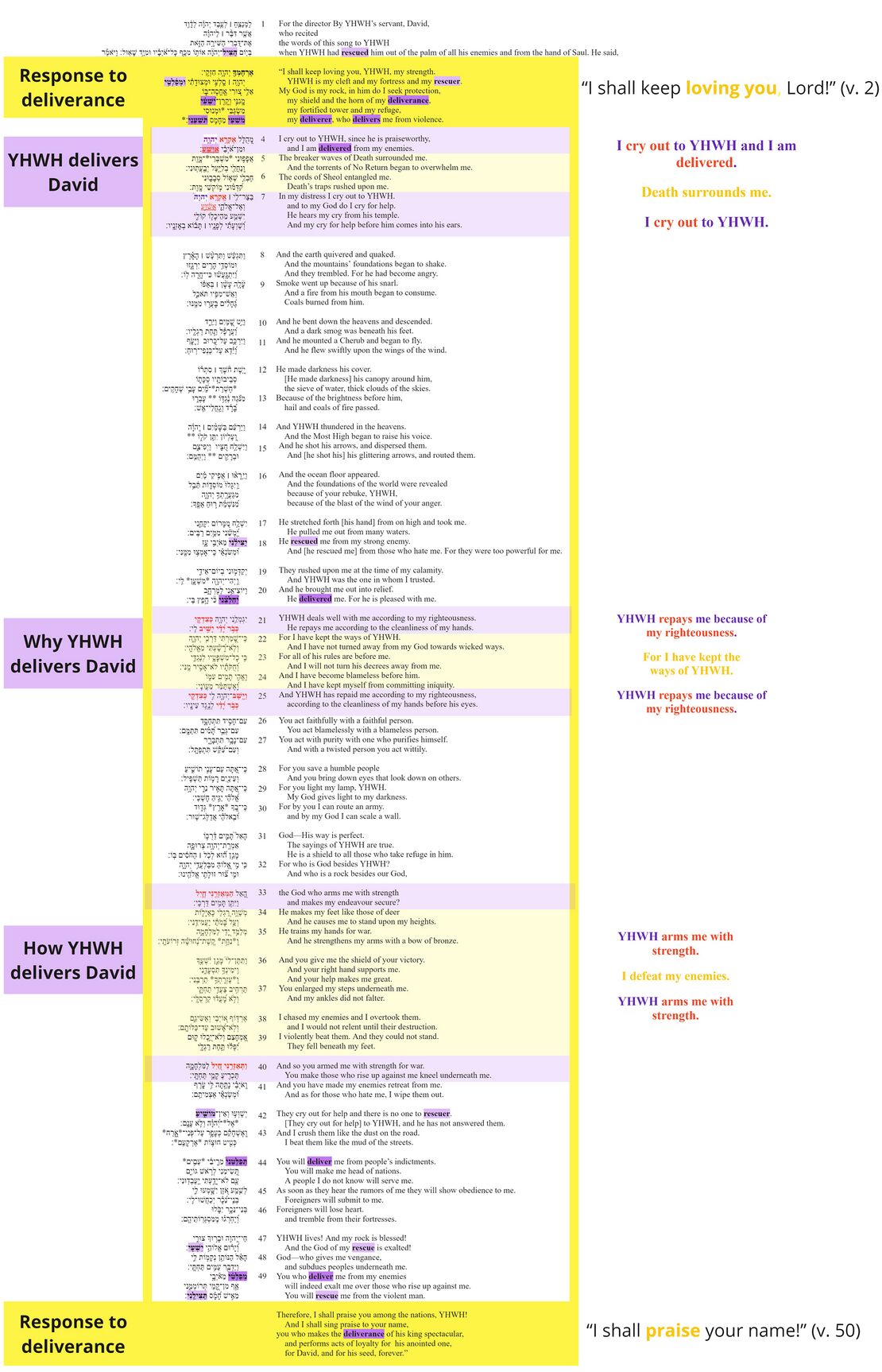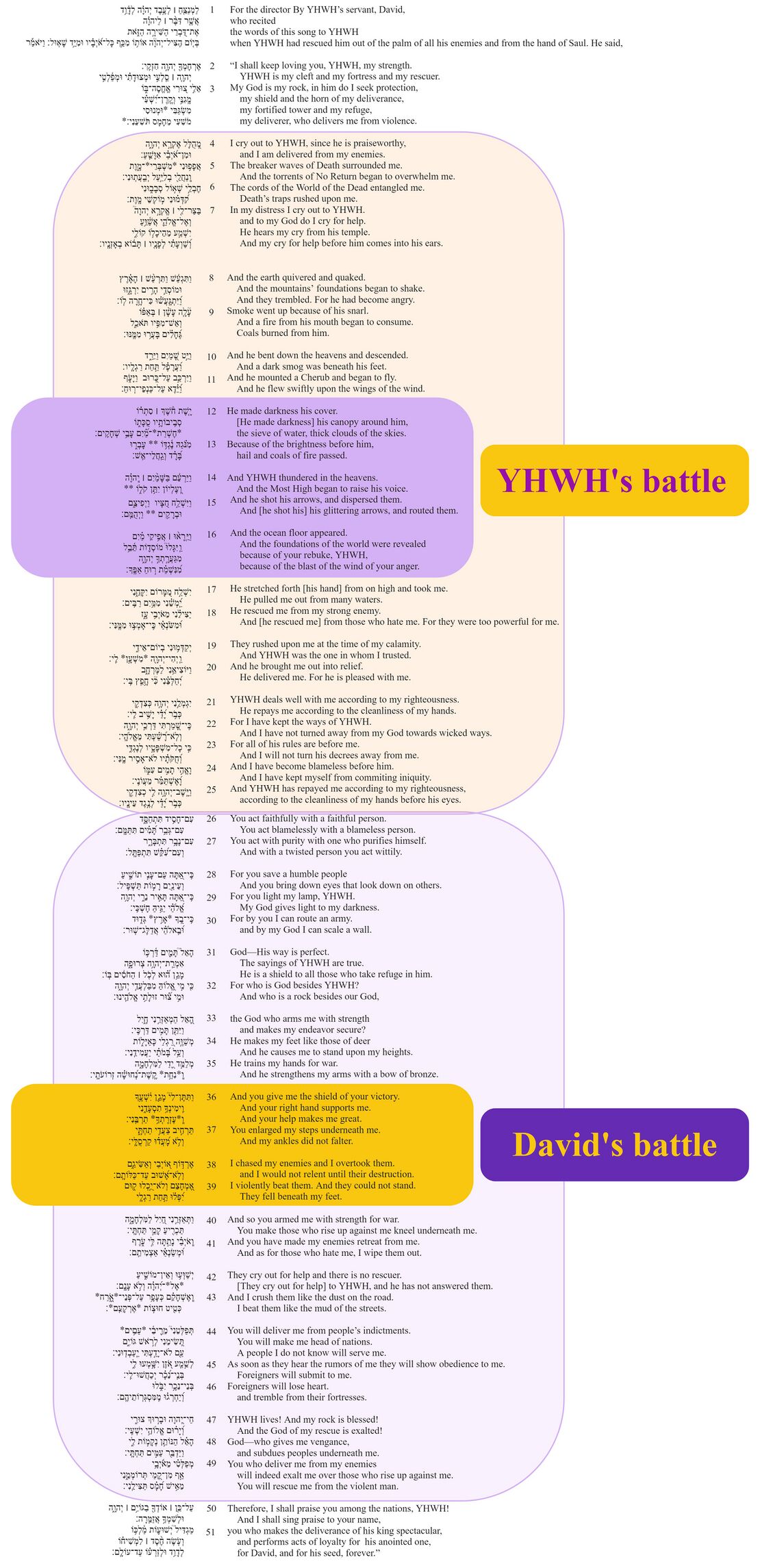Psalm 18 Poetic Features
Poetic Features
In poetic features, we identify and describe the “Top 3 Poetic Features” for each Psalm. Poetic features might include intricate patterns (e.g., chiasms), long range correspondences across the psalm, evocative uses of imagery, sound-plays, allusions to other parts of the Bible, and various other features or combinations of features. For each poetic feature, we describe both the formal aspects of the feature and the poetic effect of the feature. We assume that there is no one-to-one correspondence between a feature’s formal aspects and its effect, and that similar forms might have very different effects depending on their contexts. The effect of a poetic feature is best determined (subjectively) by a thoughtful examination of the feature against the background of the psalm’s overall message and purpose.
Iconic Rescue: "Because, you, YHWH are my strength and my protection!"
If an emendation or revocalization is preferred, that emendation or revocalization will be marked in the Hebrew text of all the visuals.
| Emendations/Revocalizations legend | |
|---|---|
| *Emended text* | Emended text, text in which the consonants differ from the consonants of the Masoretic text, is indicated by blue asterisks on either side of the emendation. |
| *Revocalized text* | Revocalized text, text in which only the vowels differ from the vowels of the Masoretic text, is indicated by purple asterisks on either side of the revocalization. |
Feature
A central theme in Ps 18 is YHWH's deliverance and rescue of David, with many references throughout the psalm: ישע deliver/deliverance (vv. 3, 28, 36, 42, 47) חלץ deliver (20) נצל rescue (1, 18, 49) פלט rescue (3, 44, 49).
Three inclusios within the Psalm iconically portray YHWH “rescuing” David. Structurally the inclusios accomplish this through YHWH's actions “surrounding” David. Semantically each inclusio describes some way in which YHWH helps David. Although there are many repeated roots in Ps 18, there are only three places where a specific phrase is repeated in close proximity, creating three noteworthy inclusios.
-The first inclusio consists of vv 4 and 7. Both verses contain the clause “I cry out to YHWH” (אֶקְרָ֣א יְהוָ֑ה). Additionally, 4b and 7b each contain a verb with yod, shin and 'ayin in the root: “I am delivered” (אִוָּשֵֽׁעַ) and “I cry for help” (אֲשַׁ֫וֵּ֥עַ), respectively.
- The second inclusio consists of vv. 21 and 25. Both verses contain the verb “he will repay” (יָשִׁ֥יב and וַיָּֽשֶׁב respectively), the phrase “according to my righteousness” (כְּצִדְקִ֑י) and the phrase “according to the cleanliness of my hands” (כְּבֹ֥ר יָ֝דַ֗י).
- The third inclusio consists of vv. 33 and 40. They are bound by the virtually identical repetition of a clause: “...who arms me with strength” (הַמְאַזְּרֵ֣נִי חָ֑יִל v. 33); “You armed me with strength” (וַתְּאַזְּרֵ֣נִי חַ֭יִל v. 40).
David's response (see below) for this deliverance is also provided iconically:
-The entire poem is flanked by identical structures, a 1cs yiqtol verb with a 2ms suffix referring to YHWH: “I shall keep loving you” (אֶרְחָמְךָ֖) in v. 2 and “I shall praise you” in v. 50 (אוֹדְךָ֖).
Effect
This structure reinforces the main message of the poem: YHWH delivers and protects David by equipping him with strength because David is committed to YHWH. In response, David continues his commitment and praise.
In v. 2 David calls YHWH his “strength” but then immediately speaks of God as his protection and deliverer in v. 3. The main message of the poem answers this tension: God protects and delivers David by strengthening him.
-The first inclusio states that YHWH delivers David. David expresses that he is surrounded by Death's instruments (vv. 5–6). At the same time, he is surrounded by a promise: whenever he cries out, YHWH answers with deliverance. This is exactly what follows in vv. 8–20, YHWH's deliverance of David from the chaotic waters.
-The second inclusio shows why YHWH delivers David. David expresses that he keeps the way of the Lord (vv. 22–24). David's efforts are not in vain, but rather protected by YHWH, for YHWH always repays David according to his righteousness (vv. 21 and 25). This is because YHWH is just, as is further elaborated in the following verses (vv. 26–32).
-The final inclusio shows how YHWH delivers David. David is equipped for war and defeats his enemies (34–39). His strength is not his own, however, but a form of YHWH's deliverance, for YHWH is the one who equips David for war (vv. 33 and 40). Because of David's great strength given by YHWH, nations submit to him as expressed in the following verses.
-Finally, the reason and result of YHWH being committed to protecting David is that David has always been committed to YHWH (reason) and will continue to be committed (result). David proclaims this at the beginning and end of the Psalm when he says “I shall keep loving you” (v. 2) and “I shall praise you” (v. 50). This is an expression of the covenant relationship between David. Thus: the flanking verses represent David's expression of his commitment to his side of the covenant, and the internal inclusios illustrate YHWH's commitment to the covenant.
My fight is your fight
If an emendation or revocalization is preferred, that emendation or revocalization will be marked in the Hebrew text of all the visuals.
| Emendations/Revocalizations legend | |
|---|---|
| *Emended text* | Emended text, text in which the consonants differ from the consonants of the Masoretic text, is indicated by blue asterisks on either side of the emendation. |
| *Revocalized text* | Revocalized text, text in which only the vowels differ from the vowels of the Masoretic text, is indicated by purple asterisks on either side of the revocalization. |
Feature
YHWH's battle and David's battle occupy a structurally similar spot in the body of the Psalm.
In poetic structure, it was demonstrated that the Psalm is divided into two halves. At the heart of each half is the deliverance event itself. The reason for two deliverance events is that one is cosmic (YHWH's) and one is material (David's). They are necessarily linked, viz., they are one and the same event, because of the covenant relationship. David is the expression on earth of YHWH's kingship. Note that vv. 42–43 are not included in David's battle because of the verbal semantics. The battle there is not narrated like that in vv. 36–39, but rather descriptive of what regularly happens.
Effect
The structural placement of the two battles poetically expresses a central concept of the Psalm: that David's battle is YHWH's battle.
In the Psalms, the king was YHWH's representative on earth (cf. Psalm 2:11–12; Keel 1997, 246–247), such that the king's enemies are God's enemies: "The Israelite king's view of his enemies can be compared with that of other sacred kings. The Assyrian king, for example, considered his enemies as enemies of his gods, guilty of impious rebellion” (Eaton 1975, 141). On the connection between YHWH's enemies and God's enemies, see the feature ‘My enemies are your enemies’.
My enemies are your enemies
If an emendation or revocalization is preferred, that emendation or revocalization will be marked in the Hebrew text of all the visuals.
| Emendations/Revocalizations legend | |
|---|---|
| *Emended text* | Emended text, text in which the consonants differ from the consonants of the Masoretic text, is indicated by blue asterisks on either side of the emendation. |
| *Revocalized text* | Revocalized text, text in which only the vowels differ from the vowels of the Masoretic text, is indicated by purple asterisks on either side of the revocalization. |
Feature
Towards the middle of the Psalm (vv. 17b, 18a), David explicitly makes a connection between the “waters” that YHWH fights in the first half of the Psalm, and his enemies, whom he defeats in the second half of the Psalm. This connection is reinforced by a number of literary features:
-The first literary link is lexical in nature. In v. 6, Death's traps “rush upon” (קִ֝דְּמ֗וּנִי) the Psalmist. The same verb is predicated of the Psalmist's enemies in v. 19. He describes them as “rushing upon” him (יְקַדְּמ֥וּנִי).
-The second literary link is achieved through imagery. A participant related to YHWH's enemies in the Psalm is the earth, who “trembles ” at YHWH's appearance in vv. 8–9. Similarly, the participants related to David's enemies, foreign nations, “tremble” at the mere rumor of David in v. 46.
-The final link is thematic and phonological. All of the 3mp suffixes throughout the Psalm refer to enemies. In v. 15, they refer to God's enemies (most likely waves, torrents, cords and traps of death back in vv. 5–6). Within the narrative of David's battle in vv. 38–43, they refer to his enemies. The verbs of which God is the subject and those of which David is the subject all express similar themes of defeating enemies: "dispersed them", "routed them" (v. 15), "overtook them", "violently beat them", "wipe them out", and "crush them" (v. 38-43). Beyond the clear thematic links, the phonological similarities between these verbs are striking. In addition to the rhyme created by the 3mp ending itself, hearing the latter set of verbs would have no doubt evoked the first set. The salient correspondences consist of gutturals, labials, sibilants, the long ī sound, and the sound -ēm created by the 3mp suffix plus its connecting vowel.
Effect
These literary links (1) support the symbolic link between water and enemies, and (2) reinforce David's equation of YHWH's enemies with his own. This is crucial to the central message of the Psalm: David is YHWH's representative on earth, because of their binding covenant relationship (cf. Psalm 2:11–12; Keel 1997, 246–247). This bond is reflected in the fact that David's enemies become YHWH's enemies (see Eaton 1974, 141), that is, what happens to one happens to both.
The symbolic link between water and enemies is that both were seen as gateways to death (May 1955, 12). Hostile enemies are life-threatening; in biblical cosmology, the earth and the place of the dead are separated by subterranean waters (Job 26:5; cf. Ps 139:8). Also, the seas are viewed as chaotic forces to be defeated, and so earthly foes can also be seen as rebellious agents of chaos to be defeated.
Another link between water and enemies is simply that, throughout scripture, YHWH is regularly seen battling the oceans and the seas (Isa 27:1; Jer 5:22; Psa 89:9–10; 104:24–26; Job 26:12).
Repeated Roots
The repeated roots table is intended to identify the roots which are repeated in the psalm.
| Repeated Roots legend | |
|---|---|
| Divine name | The divine name is indicated by bold purple text. |
| Roots bounding a section | Roots bounding a section, appearing in the first and last verse of a section, are indicated by bold red text. |
| Roots occurring primarily in the first section are indicated in a yellow box. | |
| Roots occurring primarily in the third section are indicated in a blue box. | |
| Roots connected across sections are indicated by a vertical gray line connecting the roots. | |
| Section boundaries are indicated by a horizontal black line across the chart. | |
Notes
- The divine name is the most numerous reoccurring root, occurring 19 times.
- David's name occurs in the first and last verse of the psalm.
- vv. 26–27 seem to be a fitting mid-way point for the repeated roots.
- Each verse repeats at least one root.
- No other repeated root in the psalm occurs in these two verses.
- In terms of content, vv. 26–27 express the theological truth both introduced by the Song of Hannah (see 1 Sam 2:6–8) and evident throughout the life of David—that God opposes the proud but exalts the humble (cf. Prov 3:34; James 4:6).
- The only root that occurs before, within and after the line of symmetry is תמם.
- Many of the roots that repeat in the second half of the Psalm relate to war and subsequent subduing of nations (עמם, אזר, לחם, קום, גוי, נכר, גדל).









